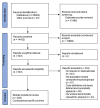Global, regional, and national prevalence of asthma in 2019: a systematic analysis and modelling study
- PMID: 35765786
- PMCID: PMC9239324
- DOI: 10.7189/jogh.12.04052
Global, regional, and national prevalence of asthma in 2019: a systematic analysis and modelling study
Abstract
Background: Asthma has a significant impact on people of all ages, particularly children. A lack of universally accepted case definition and confirmatory tests and a poor understanding of major risks interfere with a global response. We aimed to provide global estimates of asthma prevalence and cases in 2019 across four main epidemiological case definitions - current wheezing, ever wheezing, current asthma, and ever asthma. We further investigated major associated factors to determine regional and national distributions of prevalence and cases for current wheezing and ever asthma.
Methods: We identified relevant population-based studies published between January 1, 1990, and December 31, 2019. Using a multilevel multivariable mixed-effects meta-regression model, we assessed the age- and sex-adjusted associations of asthma with study-level variables, including year, setting, region and socio-demographic index (SDI). Using a random-effects meta-analysis, we then identified risk factors for current wheezing and asthma. From a "risk factor-based model", which included current smoking, and biomass exposure for current wheezing, and rural setting, current smoking, biomass exposure, and SDI for ever asthma, we estimated case numbers and prevalence across regions and 201 countries and territories in 2019.
Results: 220 population-based studies conducted in 88 countries were retained. In 2019, the global prevalence estimates of asthma in people aged 5-69 years by various definitions, namely current wheezing, ever wheezing, current asthma, and ever asthma were 11.5% (95% confidence interval (CI) = 9.1-14.3), 17.9% (95% CI = 14.2-22.3), 5.4% (95% CI = 3.2-9.0) and 9.8% (95% CI = 7.8-12.2), respectively. These translated to 754.6 million (95% CI = 599. 7-943.4), 1181.3 million (95% CI = 938.0-1,471.0), 357.4 million (95% CI = 213.0-590.8), 645.2 million (95% CI = 513.1-806.2) cases, respectively. The overall prevalence of current wheezing among people aged 5-69 years was the highest in the African Region at 13.2% (95% CI = 10.5-16.5), and the lowest in the Americas Region at 10.0% (95% CI = 8.0-12.5). For ever asthma, the estimated prevalence in those aged 5-69 years was also the highest in the African Region at 11.3% (95% CI = 9.0-14.1), but the lowest in South-East Asia Region (8.8, 95% CI = 7.0-11.0).
Conclusions: Although varying approaches to case identification in different settings make epidemiological estimates of asthma very difficult, this analysis reaffirms asthma as a common global respiratory condition before the COVID-19 pandemic in 2019, with higher prevalence than previously reported in many world settings.
Copyright © 2022 by the Journal of Global Health. All rights reserved.
Conflict of interest statement
Competing interests: IR is co-Editor-in-Chief of the Journal of Global Health. To ensure that any possible conflict of interest relevant to the journal has been addressed, this article was reviewed according to best practice guidelines of international editorial organisations. The author completed the ICMJE Unified Competing Interest Form (available on request from the corresponding author) and declare no competing interests.
Figures




References
-
- Global Asthma Network. The Global Asthma Report 2018. Available: http://globalasthmareport.org/resources/Global_Asthma_Report_2018.pdf. Accessed: 28 April 2021.
-
- Pearce N, Sunyer J, Cheng S, Chinn S, Bjorksten B, Burr M, et al. Comparison of asthma prevalence in the ISAAC and the ECRHS. ISAAC Steering Committee and the European Community Respiratory Health Survey. International Study of Asthma and Allergies in Childhood. Eur Respir J. 2000;16:420-6. 10.1183/9031936.00.16337700 - DOI - PubMed
-
- Ellwood P, Asher MI, Beasley R, Clayton TO, Stewart AW, Committee IS.The international study of asthma and allergies in childhood (ISAAC): phase three rationale and methods. Int J Tuberc Lung Dis. 2005;9:10-6. - PubMed
